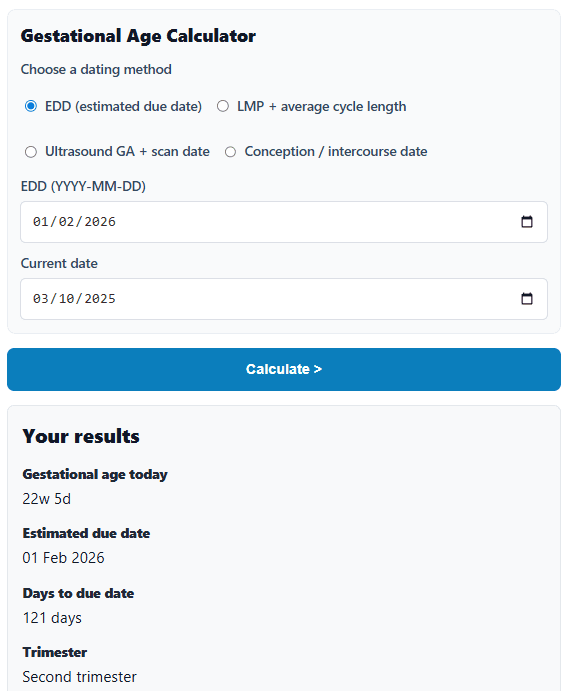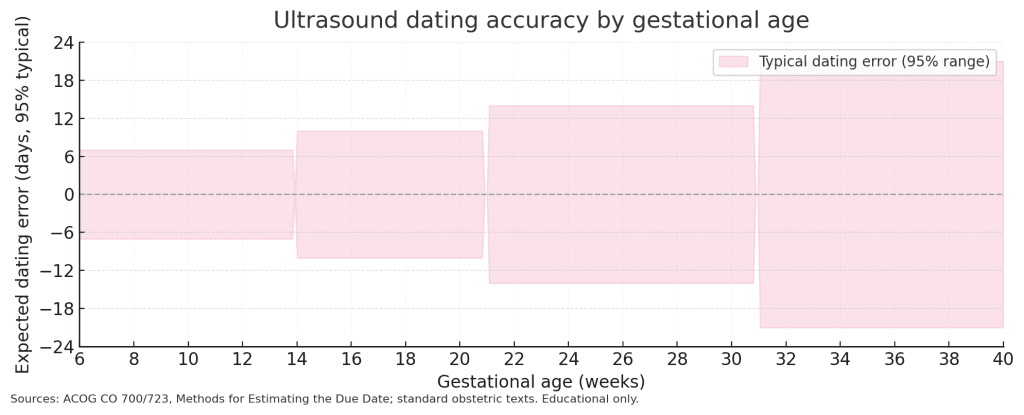Enter one date (EDD, LMP, ultrasound GA, or conception) to see an estimate of how many weeks pregnant you might be today.
If you mainly want your estimated due date and a full pregnancy timeline, you can go straight to the Pregnancy Due Date Calculator.
Methodology & sources
How this calculator works
This tool estimates gestational age today, days until the estimated due date, and a trimester label. It follows standard obstetric dating rules described in clinical guidelines.
Primary dating methods
- EDD known: If you already have an EDD (for example from a prior clinical visit), the tool infers the last menstrual period date by counting back 280 days, then counts forward to today.
- LMP + average cycle length: Naegele’s rule assumes a 28 day cycle with ovulation about day 14. If the reported average cycle differs, the LMP to ovulation interval is shifted by the difference from 28 days. EDD = adjusted LMP + 280 days.
- Ultrasound GA + scan date: If an ultrasound reported GA (weeks + days) on a scan date, the tool derives the EDD from that GA, then computes GA today by date differences. Early ultrasound is generally preferred over LMP when they disagree meaningfully.
- Conception/intercourse date: For approximate dating, LMP is estimated as 14 days before conception, then EDD = LMP + 280 days.
What we show
- Gestational age today in weeks and days.
- Days to due date.
- Trimester label using common bands: first 0–13w 6d, second 14–27w 6d, third 28w+.
Assumptions and guardrails
- Dates are treated as whole days in local time. Outputs avoid negative values.
- Cycle length adjustment is a practical heuristic. Irregular cycles, assisted reproduction, or uncertain dates may need clinician review.
- When both LMP and early ultrasound exist and disagree, early ultrasound dating is usually preferred.
Find your conception date
Estimate conception from LMP, due date, or ultrasound and see your likely window.
Open Conception Date CalculatorHow to use this calculator
- Select one input: EDD, or LMP + average cycle length, or Ultrasound GA + scan date, or Conception/intercourse date.
- Confirm the current date (defaults to today).
- See gestational age today (weeks+days), days to due date, and your trimester.
If methods disagree, ultrasound dating in early pregnancy is often preferred for accuracy. For IVF/FET, use the transfer option in the IVF calculator.

Math behind the calculator
- Current date: this is the date we measure from. It auto-fills to today. You can change it to look at a past or future visit.
- Starting from a due date (EDD): count back 280 days to find the notional “start” of pregnancy (the LMP date). Gestational age is how many days have passed from that start to the current date.
- Starting from LMP + cycle length: if your average cycle is not 28 days, shift the LMP by the difference. Example: 31-day cycles shift forward 3 days, 25-day cycles shift back 3 days. The due date is 280 days after this adjusted LMP. Gestational age is the time from the adjusted LMP to the current date.
- Starting from an ultrasound report: the scan tells you how far along you were on the scan day. To get today’s gestational age, add the days between the scan day and the current date to the reported age. From that we also show a due date based on a 280-day pregnancy length.
- Starting from a conception date: conception is assumed to be about two weeks after the LMP. We go back 14 days from the conception date to set the LMP, then work out gestational age and the due date from there.
- Weeks and days: we turn total days into whole weeks plus the leftover days. Example: 87 days = 12 weeks 3 days.
- Days to due date: we count calendar days from the current date up to the due date. If the due date has passed we show 0.
- Trimester labels: First trimester ends at 13 weeks 6 days. Second trimester runs from 14 weeks to 27 weeks 6 days. Third trimester starts at 28 weeks.
- End of 1st trimester (date): this is 13 weeks 6 days after the LMP.
- Date handling: we treat dates at local midnight to avoid off-by-one shifts from time of day or daylight saving changes.
If methods disagree, early ultrasound dating is usually the most accurate. For IVF or FET pregnancies, use our IVF/FET due date tools for transfer-based dating.

Frequently asked questions
Which input is most accurate for GA?
Early ultrasound dating is typically the most accurate method. If you have a first trimester scan, use Ultrasound Due Date. Otherwise, LMP or a known conception or intercourse date works well.
How do I calculate GA from EDD?
Enter your EDD and today’s date. The tool counts backward to show weeks+days pregnant and days remaining. If your EDD came from a scan, results reflect that dating.
How do I use LMP if my cycles aren’t 28 days?
Add your average cycle length so ovulation is adjusted from day 14. If your cycles vary a lot, compare results with the Pregnancy Due Date Calculator or an early ultrasound.
Can I calculate GA from an ultrasound report?
Yes. Enter the ultrasound GA and the scan date. The tool projects that dating forward to today and shows your trimester and days to EDD.
What if I only know the conception or intercourse date?
Use the conception/intercourse option. The tool estimates GA assuming conception near ovulation and calculates your EDD. For more detail, see Due Date by Intercourse and Conception Date.
How are trimesters labeled?
Commonly: First (0–13w6d), Second (14–27w6d), Third (28w0d+). Some clinics use slightly different cutoffs; your provider’s guidance applies.
IVF/FET: should I use this or the IVF calculator?
Use the IVF/FET Due Date Calculator for transfer-based dating (Day 3/5/6). It returns GA today and EDD using embryo age at transfer.
